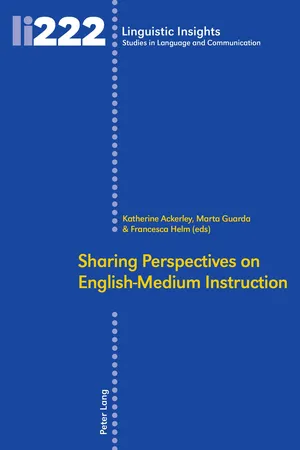
- 308 pages
- English
- PDF
- Available on iOS & Android
About this book
English is increasingly used as a medium of instruction in European higher education not only in northern countries, but also in the European 'south'. This volume is fruit of a project which was carried out in a public university based in the north-east of Italy with the aim of delivering professional development for university lecturers engaged in EMI. It begins with an overview of the European context, the Italian context, and some of the arguments against the indiscriminate spread of English as a medium of instruction in higher education. The volume then focuses on the microcontext of the university, giving voice to the various stakeholders in EMI. These include researchers, lecturers, administrative staff, those involved in professional development and students. The central part of the volume presents the views and experiences of twelve EMI lecturers from a range of academic disciplines. In sharing these perspectives on EMI, the volume hopes to stimulate critical dialogue and research on the many issues involved in this aspect of internationalisation in higher education institutions.
Frequently asked questions
- Essential is ideal for learners and professionals who enjoy exploring a wide range of subjects. Access the Essential Library with 800,000+ trusted titles and best-sellers across business, personal growth, and the humanities. Includes unlimited reading time and Standard Read Aloud voice.
- Complete: Perfect for advanced learners and researchers needing full, unrestricted access. Unlock 1.4M+ books across hundreds of subjects, including academic and specialized titles. The Complete Plan also includes advanced features like Premium Read Aloud and Research Assistant.
Please note we cannot support devices running on iOS 13 and Android 7 or earlier. Learn more about using the app.
Information
Table of contents
- Cover
- Table of Contents
- Acknowledgements
- Introduction to this volume (Francesca Helm)
- Part 1: The Macro Contexts
- Part 2: The Micro Context
- Part 3: Lecturers’ Perspectives
- Part 4: Students’ Perspectives